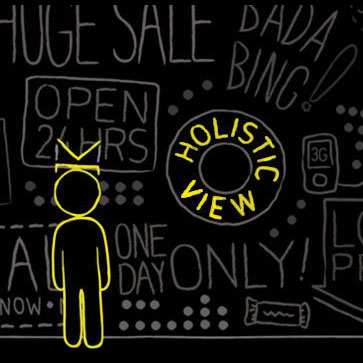Digital Influence & Advertising

Each Super Bowl, big brands reach into their deep pockets to call attention to their business for the purpose of selling products or services, and 2015 was no different. Everyone from T-Mobile to Wix.com showed they had access to the biggest stars and the best writers for their pricey commercials.
So pricey, in fact, that this year's Super Bowl advertisers paid $4.5 million for 30 seconds of airtime.
What could $4.5 million buy on the Web?
Programmatic media buying platform RocketFuel found that for the same cost as a 30-second Super Bowl TV spot, digital advertisers could buy an 11-day takeover of the YouTube homepage, a nine-day takeover of Turner Networks' affiliated Web pages (e.g. TNT.tv, CNN.com, NBA.com, Adult Swim, etc.), 45 days of standalone ads on Facebook's logout page and more than 37 days of promoted trends on Twitter (paid positioning atop the network's Trends feature). That's a lot of potential influence, which big brands would be smart to explore.
The Super Bowl's Winners & Losers
See which Super Bowl advertisers scored big - and which ones passed at the one-yard line.
What online advertising affords is more control over messaging and more control over how and when that messaging is delivered. Advertising today is no longer about the number of eyeballs on a screen (nor is it about the number of clicks from a display ad). Advertisers with sophisticated acquisition strategies understand the significant shift occurring today - that advertising for awareness (and clicks) is only a means to an end, but advertising for influence has the potential to create greater profits and lasting relationships. To build influence, the savviest advertisers are creating messaging that not only calls attention to their products and services, but also how consumers view the world - developing content that is reflective of a user's needs and sharing it at a moment in time when it's most impactful. In many ways, it's the end of 'Net advertising as you know it - as well as the beginning.
CONTENT ADVERTISING
In droves, 'Net professionals are shying away from traditional brand-centric advertising, seeing the potential in marketing the content they've created, like videos, blogs, whitepapers, infographics and more. This is most commonly referred to as content marketing, "a strategic marketing approach focused on creating and distributing valuable, relevant and consistent content to attract and retain a clearly defined audience - and, ultimately, to drive profitable customer action" (source: Content Marketing Institute). This approach is very popular - to say the least - among 'Net professionals and is changing how companies are advertising today.
In fact, content is being created at such a rapid clip, that 70 percent of business-to-business (B2B) marketers are creating more content than they did one year ago (source: Content Marketing Institute, 2015). Content creation, however, can be time consuming when writers and designers aren't at the ready, but online tools like free infographic builders are eliminating some of the resources needed to produce content. Popular online solutions like Canva and easel.ly (discover more content marketing tools) provide simple drag-and-drop features to create infographics, which is one of the most popular forms of content being created today. This is because brands have very limited time to capture and keep Internet users' attention, and infographics provide plenty of information in an easy-to-consume way - large numbers, short copy, interesting images/themes. What's more, the content that is included in infographics often reduce customer pain points, remove barriers to acquisition and quickly educate buyers to a brand's way of thinking.
Content can be one of the most effective ways to build influence in both the short and long term. According to Yahoo, when people view content marketing across Yahoo and Tumblr, unaided brand awareness (consumers can recall a brand without any prompts, such as "name three luxury car brands" versus "are you familiar with Lexus?") increases by 40 percent, brand consideration grows 31 percent and tagline recognition increases by 100 percent.
The reasons why brands are using content marketing are clear, but many companies have yet to explore the various advertising opportunities available to distribute said content to increase exposure and drive traffic back to their websites (where conversions can happen).
One of the most popular paid methods to advertise content is through content discovery tools, like Outbrain (pictured). With its Amplify product, brands simply provide a link to their content and then Outbrain serves it to publisher sites like CNN.com and ESPN.com, where links to a brand's content appear as recommendations or promoted stories.
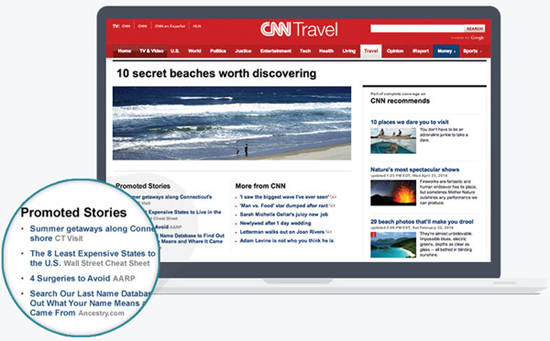
Outbrain is a budget-friendly option to raise awareness of content, as it works on a pay-per-click model and lets advertisers control their budgets.
The Outbrain example (a recommendation widget) is a type of native advertising that is also provided by companies like Taboola, Disqus and Gravy, and is one of six native advertising units named by the Interactive Advertising Bureau (IAB). See the other types of native advertising units (and examples).
By definition, native advertising is material that is created with the intent to resemble the platform on which it appears. Native advertising is yet another way brands are controlling the conversation - creating and promoting messaging that subtly addresses what their audience is talking about, or why they are or are not buying from them. This was the case with global healthcare company Abbott.
Removing Barriers to Acquisition
Moms are one of the most important demographics in the business-to-consumer world (a multitrillion dollar market), but for formula brands, they are everything. Today, however, there is a significant cultural shift where pediatricians, hospitals, influential bloggers and peer groups are strongly recommending against giving babies formula unless deemed medically necessary (opting to promote the alternative, natural method instead).
This, along with the fact that its own survey stated 95 percent of its target demographic feel judged or criticized for their parenting decisions, is clearly a barrier to acquisition for Similac, a formula brand by Abbott Nutrition. What is Similac, a brand that relies on moms to buy its products, to do? They create a content piece - a roughly 2.5-minute online commercial housed on a landing page, YouTube page and Facebook page - that tells moms everything is going to be OK and very subtly tells them that despite the conversation that is currently taking place, it's OK to buy formula.
The "Sisterhood of Motherhood" video is a fun but poignant video that brings to light how parents often judge each other. More so, the video, according to Lindsy Delco, director of public affairs at Abbott Nutrition, is a content piece - a way to spark further conversation around an existing dialogue among parents.
"We make formula, and parents who use our products are often judged for their decision, so we have a stake in fostering support," said Delco. "But it's much bigger than that, there are also a lot of other decisions that parents make - like working or staying home or how to discipline your kids - that are often judged. We're hoping to inspire a spirit of acceptance among parents but also continue important conversations about parenting."
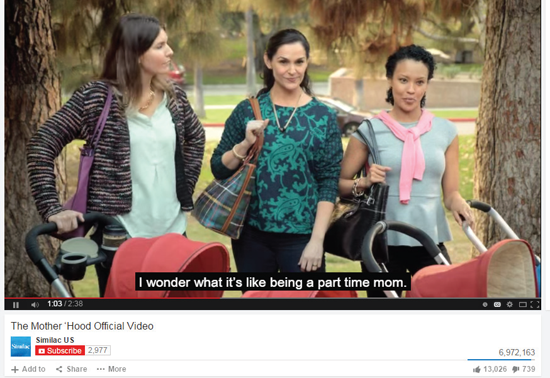
According to Delco, the video was not intended to promote or sell product. In fact, the product is never shown and the branding in the video is delayed - the campaign's name and corresponding hashtag, as well as the Similac logo, only appear in the final seconds. Be that as it may, this now-viral content can empower the brand's audience (women) to feel good about their choices (like using formula, which the video's creator offers). In turn, Similac has called attention to its products and how its consumers view the world - building influence with every view, every social share and every conversation it changes.
Discovering Pain Points
Solving customer pain points (or addressing them like Similac did) is the starting point for good content that motivates people to click on ads. Brands would be wise to set up a social listening tool (ViralHeat, Simply Measured and Social Mention are popular ones) to discover and act on what's important to their audience. What are people happy about? What makes them sad? Why are they scared? Why are they talking about a company in a negative way? The list goes on and on.
For Web Talent Marketing, Google is a major pain point for their current and prospective clients. A provider of SEO Services, Web Talent Marketing supported Online PR Specialist Emily Long in creating an SEO version of Taylor Swift's popular song "Blank Space," which acted as if Google addressed its war on Web spam through a familiar melody (e.g. "Oh my my, look at that page. It looks like your next mistake. Stuffed with keywords, your site's a fake." ).
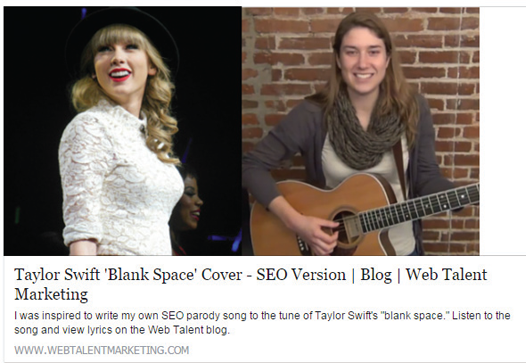
The "Blank Space" parody has been viewed nearly 10,000 times on YouTube alone. More impressively, WebTalentMarketing.com's site traffic nearly doubled the month it was released, according to Similar Web data. To spark interest, the Web Talent Marketing staff promoted the video through organic social sharing - especially on Twitter where industry thought leaders are more accessible than on other social media platforms. The content piece was also advertised on LinkedIn and Facebook, shared in relevant Google+ groups and promoted in several industry roundups.
In addition to the roundup emails, a retweet from Matt Cutts was pretty cool!" said Long. "It's not every day that the head of Google's Web spam team views your content." To measure the video's success, the team at Web Talent Marketing looked at the number of views, social traction, traffic to that particular page on their blog, time on page and sentiment (people loved it and they were telling them). More importantly, next time a prospective client of Web Talent Marketing needs something SEO related, they will likely turn to the company thanks to the increased awareness and previously established influence.
Brands that are creating content like Similac and Web Talent Marketing may want to consider looking into solutions that enable them to "harness the power of attention" they generate. Genesis Media, for example, provides a platform to monitor when content is picking up steam (increased frequency of visits, longer time on site, etc.) and creates an ad to deliver to readers/viewers who have shown interest in this particular piece of content. Since the Genesis Attention Platform (GAP) runs on every page of its partner publishers' sites, GAP can deliver ads to engaged users at the moment it will be most impactful - a dramatic shift in advertising, for sure.
With the majority of brands creating content to influence their audiences today, it's time for companies to rethink everything they know about advertising. They need to look at their social data, find out what people are talking about, why they are or are not buying from them and create content that addresses all of those issues and then find the right platform to promote (and advertise) said content.
Due to its popularity, there might be no better place than social. According to an ExactTarget report, 75 percent of consumers peruse social networking sites at least once a day from their phones. What's more, Facebook is quickly becoming a discovery tool for finding product information online, second only to Google. Finally, following search engine marketing, promoted posts (e.g. promoted Tweets) and social ads (e.g. LinkedIn ads) are considered the most effective paid advertising methods to distribute content.
STRETCHING SOCIAL
Social media networks, specifically Facebook, could one day rival search engines when it comes to how customers discover products and services. According to end-of-2014 data from BI Intelligence, advertisers are following customers to social too. In fact, social-media advertising will grow to nearly $14 billion in 2018, a five-year compound annual growth rate of 18 percent. What's more, BI Intelligence data indicates that social programmatic ad platforms are also growing, stating that spending on FBX, Facebook's programmatic platform, increased by 150 percent year-over-year globally during the second quarter of 2014.
Jan. 2015 data from Neustar echoes a similar sentiment, indicating that social now represents close to 30 percent of all exchange-based traffic (when a company programmatically facilitates buying of display, video, mobile and social ad inventory).
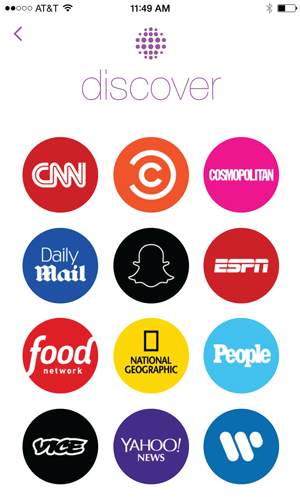 While brands continue to push large portions of their ad spend to social networks like Facebook, emerging social networks are looking to get their share of ad dollars. Most recently, Snapchat launched its anticipated Discover feature, a new way to explore stories from different editorial teams. At launch, there were 11 publishers (CNN, Comedy Central, Cosmopolitan, Daily Mail, ESPN, Food Network, National Geographic, People, Vice, Yahoo News and Warner Music Group).
While brands continue to push large portions of their ad spend to social networks like Facebook, emerging social networks are looking to get their share of ad dollars. Most recently, Snapchat launched its anticipated Discover feature, a new way to explore stories from different editorial teams. At launch, there were 11 publishers (CNN, Comedy Central, Cosmopolitan, Daily Mail, ESPN, Food Network, National Geographic, People, Vice, Yahoo News and Warner Music Group).
These publishers create "editions" that are refreshed every 24 hours and are used to promote their articles, videos, full-screen photos and advertising. Publishers can even sell their own advertising space within their content. According to Digiday, the partner media companies will retain 70 percent of ad revenue for deals they forge themselves, and half when Snapchat closes the deal.
PUSHING PROGRAMMATIC
Snapchat's Discover feature is one more way the advertising landscape is changing for both advertisers and publishers, but one of the most important changes to advertising in the 21st Century is that of programmatic, which automates ad buying by using the parameters that advertisers have set, like bid price and audience type. Programmatic has changed advertisers' expectations, in both what they are willing to pay for advertising and how much control they have over who sees their messages and when.
Cost and audience control are two reasons that U.S. programmatic digital display ad spending is expected to grow 137.1 percent to top $10 billion this year, according to recent figures from eMarketer. This accounts for 45 percent of the U.S. digital display advertising market.
THE END (AND BEGINNING) OF AN ERA
The majority of advertisers will never find themselves in front of a Super Bowl audience nor ever have access to a multimillion dollar ad budget, but every piece of content they create and promote, every new social network they look to explore and every ad buying decision they make, has super-sized implications.
As they look to find the right mix of paid, earned and owned media, they should know the principles of advertising and influence remain the same. They need to prove the risk is worth the reward, remove the barriers to acquisition, identify and mitigate pain points, be where their audience is and stay on top of developing technologies to help them share their content to the right audience and at the moment when it will be most impactful.









